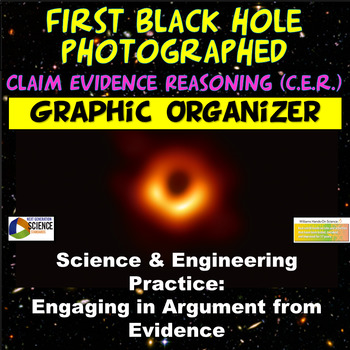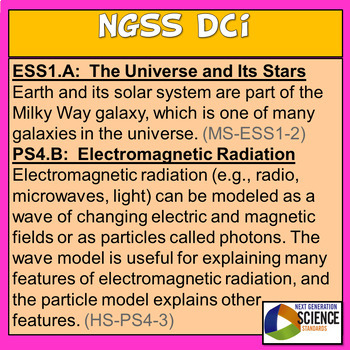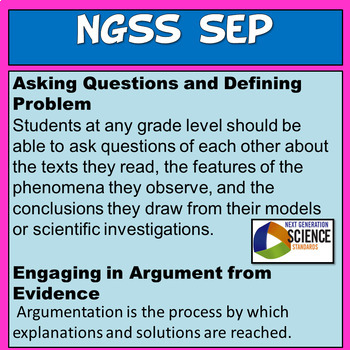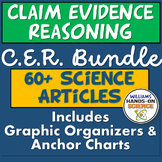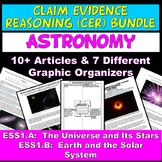Claim Evidence Reasoning Reading (CER) ESS1.A PS4.B 1st Photograph of Black Hole
- Zip
What educators are saying
Also included in
- This resource is packed with easy to use, easy to grade, no prep, scientific current events, using the NGSS Science and Engineering practice of Engaging in Argument from Evidence. Students learn about a variety of science topics through a C.E.R. (Claim Evidence Reasoning) graphic organizers. This isPrice $47.00Original Price $91.75Save $44.75
- Students learn about various current events and discoveries in Astronomy through a C.E.R. (Claim Evidence Reasoning) graphic organizer. This is great for getting your students to explain phenomena in a meaningful way and it allows you as the instructor to adequately assess their understanding of conPrice $34.00Original Price $66.50Save $32.50
Description
Students learn how the first photograph of a black hole was made through a C.E.R. (Claim Evidence Reasoning) graphic organizer. This is great for getting your students to explain phenomena in a meaningful way and it allows you as the instructor to adequately assess their understanding of concepts. The students figure out what the "Claim" is in the article, they then use data that supports the claim in the "Evidence" section, draw visual evidence and then explain why the evidence supports the claim in the "Reasoning" section.
The article has the following concepts:
Black Holes
Gravity
Electromagnetic Spectrum
X-Rays & Gamma-Rays
Speed of Light
Light Years
This is great for a current event, sub plan, homework, critical thinking, scaffolding and/or reinforcement of concepts!
You get a CER graphic organizer, the key, an editable key, the article, tips for CER and the link to the website in the article.
Save money and buy my CER Growing Resource Bundle with 25+ articles and growing.
NGSS Standards:
DCI's:
ESS1.A: The Universe and Its Stars
Earth and its solar system are part of the Milky Way galaxy, which is one of many galaxies in the universe. (MS-ESS1-2)
PS4.B: Electromagnetic Radiation
Electromagnetic radiation (e.g., radio, microwaves, light) can be modeled as a wave of changing electric and magnetic fields or as particles called photons. The wave model is useful for explaining many features of electromagnetic radiation, and the particle model explains other features. (HS-PS4-3)
SEP's
Asking Questions and Defining Problem:
Students at any grade level should be able to ask questions of each other about the texts they read, the features of the phenomena they observe, and the conclusions they draw from their models or scientific investigations.
Engaging in Argument from Evidence:
In 9–12 builds on K–8 experiences and progresses to using appropriate and sufficient evidence and scientific reasoning to defend and critique claims and explanations about the natural and designed world(s). Arguments may also come from current scientific or historical episodes in science.
CCC's
CCC1: Patterns
Observed patterns of forms and events guide organization and classification, and they prompt questions about relationships and the factors that influence them.
Thank you for taking a look!
Please follow me on TpT for new products and check me out on Instagram for my products in action!
https://www.instagram.com/williamshandsonscience/
Related Products
⭐ Claim Evidence Reasoning (CER) North Korea Missile Launch
⭐ Claim Evidence Reasoning (CER) The Physics of Car Crashes
⭐ Claim Evidence Reasoning (CER): Autumn Equinox Can Fall on Different Days
⭐ Claim Evidence Reasoning California Mudslides (Current Event and Sub Plan)
⭐ Claim Evidence Reasoning Growing Bundle
⭐ Claim Evidence Reasoning Plate Tectonics Pangaea Article and Graphic Organizer
⭐ Claim Evidence Reasoning: Government Report on Human Caused Climate Change
⭐ Hurricane Harvey Claim Evidence Reasoning Graphic Organizer
⭐ Hurricane Harvey Claim Evidence Reasoning Graphic Organizer (NatGeo Article)
⭐ Hurricane Irma CER (Claim Evidence Reasoning) Graphic Organizer
⭐ Hurricane Irma Tracker and PowerPoint
⭐ Hurricane Tracker Template & PowerPoint
⭐ NGSS 5E Natural Selection Computer Simulation
⭐ NGSS Black Holes & Galaxies Claim Evidence Reasoning Graphic Organizer
⭐ NGSS Claim Evidence Reasoning (CER) Big Bang Graphic Organizer
⭐ NGSS Claim Evidence Reasoning (CER) High Frequency Sound Waves
⭐ NGSS Claim Evidence Reasoning (CER) Kilauea Volcano Eruption Earthquakes
⭐ NGSS Claim Evidence Reasoning (CER) Oldest Evidence of Life on Land Found
⭐ NGSS Claim Evidence Reasoning The Mysterious Planet Nine Solar System Astronomy
⭐ NGSS Claim Evidence Reasoning (CER) Water Found on Mars
⭐ NGSS Climate Change & Extreme Weather Claim Evidence Reasoning
⭐ NGSS Common Core Claim Evidence Reasoning (CER) Graphic Organizers
⭐ NGSS Current Event Claim Evidence Reasoning California Wildfires
⭐ NGSS Current Event Claim Evidence Reasoning Climate Change May Change Ecosystems
⭐ NGSS Expanding Universe Claim Evidence Reasoning Graphic Organizer
⭐ NGSS Mysterious New Form of DNA Claim Evidence Reasoning Graphic Organizer

